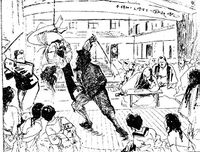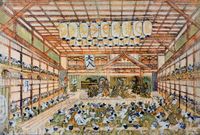Difference between revisions of "History of SM Shows"
| (4 intermediate revisions by the same user not shown) | |||
| Line 1: | Line 1: | ||
| − | + | [https://smpedia.com/index.php?title=SMショーの歴史 SMショーの歴史] | |
| − | The history below is an inclusive categorization of erotic sadomasochism in live theater | + | The history below is an inclusive categorization of bondage, torment and/or erotic sadomasochism in live theater in Japan. |
{| align="right" | {| align="right" | ||
| Line 11: | Line 11: | ||
==Edo Period Theater== | ==Edo Period Theater== | ||
| − | 1678: | + | 1678: "Sansho Dayu Anju-Hime," in Moronobu Hishikawa's "The Story of Actors Past and Present."<ref group="※">''Edo Period Literature'' (Tosho Kankokai, 1916)</ref> Itahashiya-Hime is abused with her hands tied behind her back. By this time, torment scenes were already being hinted at in kabuki theater. |
| + | |||
| + | 1700s: Punishment scenes in kabuki and ningyō jōruri (puppet theater accompanied by shamisen) are thought to rattle a person's mind.<sup><span style="color:#0000ff">[citation needed]</span></sup> | ||
| + | |||
| + | 1740: "Steps of Chujohime's Torment" (step three from "The Mountain Goddess Sutematsu" by Namiki Sousuke). | ||
| + | |||
| + | 1772: "Akegarasu Yume no Awayuki"<ref>A work of Shinnai jōruri recitation</ref> | ||
| + | |||
| + | ==Meiji Theater== | ||
| + | [[image:Moritaza.jpg|200px|thumb|Moritaza in the 1790s]] | ||
| + | 1872: "Kaidan Shikishima Monogatari" by Mokuami Kawatake is first performed by Tanosuke Sawamura III at Moritaza in March. | ||
| + | |||
| + | ==Modern Theater== | ||
| + | 1921: "Burning Her Alive" by Senzaburo Suzuki is performed at the Imperial Playhouse in November.<ref group="※">[[Ko Minomura]]. "A Great Star Has Fallen" (SM Collector, Nov 1980)</ref> The main character and setting is modeled after [[Seiu Ito]] and his studio at the time. | ||
| + | |||
| + | 2014: Oct. "Nagauta Bo Shibari" at Kameari Lirio Hall | ||
==Pink Live Shows== | ==Pink Live Shows== | ||
==SM Shows== | ==SM Shows== | ||
| − | |||
| − | |||
==Notes== | ==Notes== | ||
| Line 26: | Line 39: | ||
==External Links== | ==External Links== | ||
| − | + | * [https://www.youtube.com/watch?v=55oi_wowFqk Akegarasu Yume no Awayuki Vol.1] | |
| + | * [https://www.youtube.com/watch?v=1epLSQc6B18 Nagauta Bo Shibari (2014 October)] | ||
{{DEFAULTSORT: History of SM Shows}} | {{DEFAULTSORT: History of SM Shows}} | ||
[[Category:Nawa world]] | [[Category:Nawa world]] | ||
[[Category:index]] | [[Category:index]] | ||
Latest revision as of 15:16, 25 January 2022
The history below is an inclusive categorization of bondage, torment and/or erotic sadomasochism in live theater in Japan.
 “Flesh Market” at the Kannon Theater in Asakusa. From Seiu Ito’s “Non-Fiction - Sexual Fluids (11)”. Kitan Club Dec 1954 issue. |
Edo Period Theater
1678: "Sansho Dayu Anju-Hime," in Moronobu Hishikawa's "The Story of Actors Past and Present."[※ 1] Itahashiya-Hime is abused with her hands tied behind her back. By this time, torment scenes were already being hinted at in kabuki theater.
1700s: Punishment scenes in kabuki and ningyō jōruri (puppet theater accompanied by shamisen) are thought to rattle a person's mind.[citation needed]
1740: "Steps of Chujohime's Torment" (step three from "The Mountain Goddess Sutematsu" by Namiki Sousuke).
1772: "Akegarasu Yume no Awayuki"[1]
Meiji Theater
1872: "Kaidan Shikishima Monogatari" by Mokuami Kawatake is first performed by Tanosuke Sawamura III at Moritaza in March.
Modern Theater
1921: "Burning Her Alive" by Senzaburo Suzuki is performed at the Imperial Playhouse in November.[※ 2] The main character and setting is modeled after Seiu Ito and his studio at the time.
2014: Oct. "Nagauta Bo Shibari" at Kameari Lirio Hall
Pink Live Shows
SM Shows
Notes
- ↑ A work of Shinnai jōruri recitation
References (※)
- ↑ Edo Period Literature (Tosho Kankokai, 1916)
- ↑ Ko Minomura. "A Great Star Has Fallen" (SM Collector, Nov 1980)
